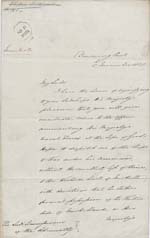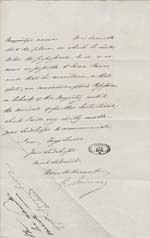

Instructions to the Admiralty to take formal possession of the western portion of the continent 5 November 1828 (UK)
Significance
These Instructions from the Colonial Secretary order the occupation and formal possession of western Australia effected by Captain Fremantle of the HMS Challenger on 2 May 1829.
History
Unlike all of the other colonies except South Australia, Western Australia (also known as the Swan River Colony) was founded directly from the United Kingdom, initially as a private enterprise colony, and no part of its territory was ever part of New South Wales. The decision to instruct the Admiralty to take formal possession of the western portion of the Australian continent was an essential preliminary to the foundation of the Swan River Colony.Prior to the decision to found the colony, a party of convicts and soldiers had been sent to King George's Sound under the command of Major Lockyer. They arrived on 26 December 1826, but in 1831 the military and prisoners were withdrawn and the area was transferred to the Swan River Colony Government. During the second half of 1828, as plans were being formulated for the formation of a private association to settle the Colony, Captain James Stirling, who had in the previous year explored the area around the mouth and lower reaches of the Swan River, wrote to the Under Secretary for the Colonies, informing him that:
� His Majesty's right to that country has never been declared, and as it is reported that the French Government contemplates the formation of a settlement in New Holland, the apprehension is that an expedition proceeding there might find, on its arrival, the best positions occupied and its aim defeated, to the total ruin of the property� I take the liberty of suggesting that [the difficulties] may be obviated by dispatching at once a ship of war to that quarter. Possession might thus be taken of the country surveys commenced, and arrangements made for the reception of settlers.
Stirling's suggestion was acted upon and on 5 November 1828, the Colonial Secretary, Sir George Murray, instructed the Admiralty to order the officer commanding the naval forces at the Cape to despatch a ship to the coast of New Holland and to take formal possession of the territory. Uninterrupted possession was to be maintained until the arrival of further advice.
On 10 March 1829, HMS Challenger under the command of Captain Fremantle set sail from the Cape. On the morning of 2 May the Captain and party from the ship landed on the mainland and took formal possession of the west coast of New Holland in the name of His Majesty the King. This action cleared the way for the arrival of Stirling and the first party of settlers a few weeks later.
Sources
Appleyard, RT and Manford, T, The Beginning: European Discovery and Early Settlement of Swan River Western Australia, University of Western Australia Press, Perth, 1979.
Battye, JS, Western Australia: A History from its Discovery to the Inauguration of the Commonwealth, Oxford, Clarendon Press, 1924.
Clark, CMH, Select Documents in Australian History, 1788–1850, Angus & Robertson, Sydney, 1950.
Crowley, FK, Australia's Western Third: A History of Western Australia From the First Settlements to Modern Times, Macmillan, London, 1960.
Stannage, CT, A New History of Western Australia, University of Western Australia Press, Perth, 1981.
Description
| Long Title: | Instructions to the Admiralty to take formal possession of the western portion of the continent 5 November 1828 (UK) |
| No. of pages: | 2 |
| Medium: | Paper |
| Measurements: | Unknown |
| Provenance: | Colonial Office |
| Features: | n/a |
| Location & Copyright: | National Archives of the United Kingdom |
| Reference: | ADM/1/4242 |

